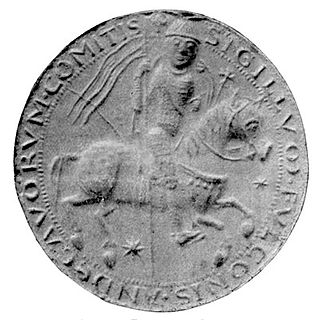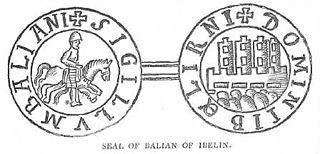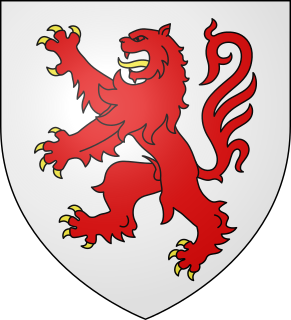Related Research Articles
The 1100s was a decade of the Julian Calendar which began on January 1, 1100, and ended on December 31, 1109.

Baldwin III was King of Jerusalem from 1143 to 1163. He was the eldest son of Melisende and Fulk of Jerusalem. He became king while still a child, and was at first overshadowed by his mother Melisende, whom he eventually defeated in a civil war. During his reign Jerusalem became more closely allied with the Byzantine Empire, and the Second Crusade tried and failed to conquer Damascus. Baldwin captured the important Egyptian fortress of Ascalon, but also had to deal with the increasing power of Nur ad-Din in Syria. He died childless and was succeeded by his brother Amalric.

Fulk, also known as Fulk the Younger, was the count of Anjou from 1109 to 1129 and the king of Jerusalem from 1131 to his death. During his reign, the Kingdom of Jerusalem reached its largest territorial extent.

The Principality of Antioch was one of the crusader states created during the First Crusade which included parts of modern-day Turkey and Syria. The principality was much smaller than the County of Edessa or the Kingdom of Jerusalem. It extended around the northeastern edge of the Mediterranean, bordering the County of Tripoli to the south, Edessa to the east, and the Byzantine Empire or the Kingdom of Armenia to the northwest, depending on the date.
Raymond III was count of Tripoli from 1152 to 1187. He was a minor when Assassins murdered his father, Raymond II of Tripoli. Baldwin III of Jerusalem, who was staying in Tripoli, made Raymond's mother, Hodierna of Jerusalem, regent. Raymond spent the following years at the royal court in Jerusalem. He participated in a series of military campaigns against Nur ad-Din, the Zengid ruler of Damascus, after he reached the age of majority in 1155. Raymond hired pirates in 1161 to pillage the Byzantine coastline and islands to take vengeance on Byzantine Emperor Manuel I Komnenos, who had refused to marry his sister Melisende. Captured in the Battle of Harim by Nur ad-Din's troops on 10 August 1164, he was imprisoned in Aleppo for almost ten years. During his captivity, Amalric I of Jerusalem administered the county of Tripoli on his behalf.

Raymond II was count of Tripoli from 1137 to 1152. He succeeded his father, Pons, Count of Tripoli, who was killed during a campaign that a commander from Damascus launched against Tripoli. Raymond accused the local Christians of betraying his father and invaded their villages in the Mount Lebanon area. He also had many of them tortured and executed. Raymond was captured during an invasion by Imad ad-Din Zengi, atabeg of Mosul, who gained the two important castles of Montferrand and Rafaniya in exchange for his release in the summer of 1137.

The Crusader state of the Kingdom of Jerusalem, created in 1099, was divided into a number of smaller seigneuries. According to the 13th-century jurist John of Ibelin, the four highest crown vassals in the kingdom proper were the count of Jaffa and Ascalon, the prince of Galilee, the lord of Sidon, and the lord of Oultrejordain.

The count of Tripoli was the ruler of the County of Tripoli, a crusader state from 1102 through 1289. Of the four major crusader states in the Levant, Tripoli was created last.

There were six major officers of the kingdom of Jerusalem: the constable, the marshal, the seneschal, the chamberlain, the butler and the chancellor. At certain times there were also bailiffs, viscounts and castellans.

Prince of Antioch was the title given during the Middle Ages to Norman rulers of the Principality of Antioch, a region surrounding the city of Antioch, now known as Antakya in Turkey. The Princes originally came from the County of Sicily in Southern Italy. After 1130 and until 1816 this county was known as the Kingdom of Sicily. Prince Bohemond IV of Antioch additionally came into possession of the County of Tripoli, combining these two Crusader states for the rest of their histories.

Balian of Ibelin, also known as Barisan the Younger, was a crusader noble of the Kingdom of Jerusalem in the 12th century. He was lord of Ibelin from 1170 to 1193. As the leader of the defense of the city during the siege of Jerusalem in 1187, he surrendered Jerusalem to Saladin on October 2, 1187.

The Principality of Galilee was one of the four major seigneuries of the crusader Kingdom of Jerusalem, according to 13th-century commentator John of Ibelin. The direct holdings of the principality centred around Tiberias, in Galilee proper, but with all its vassals, the lordship covered all Galilee and southern Phoenicia. The independent Lordship of Sidon was located between Galilee's holdings. The principality also had its own vassals: the Lordships of Beirut, Nazareth, and Haifa.
The Principality of Antioch mirrored the Latin Kingdom of Jerusalem in its selection of great offices: constable, marshal, seneschal, admiral, Chamberlain, butler, chancellor and at certain times also bailiff.
The Kingdom of Cyprus, as an offshoot of the Kingdom of Jerusalem, maintained many of the same offices, such as: seneschal, constable, marshal, admiral, Chamberlain, and chancellor.

The Ramnulfids, or the House of Poitiers, were a French dynasty ruling the County of Poitou and Duchy of Aquitaine in the 9th through 12th centuries. Their power base shifted from Toulouse to Poitou. In the early 10th century, they contested the dominance of northern Aquitaine and the ducal title to the whole with the House of Auvergne. In 1032, they inherited the Duchy of Gascony, thus uniting it with Aquitaine. By the end of the 11th century, they were the dominant power in the southwestern third of France. The founder of the family was Ramnulf I, who became count in 835.

Guérin de Montaigu, also known as Garin de Montaigu or Pierre Guérin de Montaigu, was a nobleman from Auvergne, who became the fourteenth Grand Master of the Knights Hospitaller, serving from 1207–1228. He succeeded the Grand Master Geoffroy le Rat after his death in 1206, and was succeeded by Bertrand de Thessy.

The Embriaco were a prominent Genoese family, who played an important role in the history of the Crusader states. It also gave consuls, admirals and ambassadors to the Republic of Genoa.
The officers of the County of Edessa were the appointed officials in charge of various aspects of the government of the county. The offices they held pertained to the management of the count's household and the military defence of the county. The same offices existed in the other Crusader states, but given the early collapse of Edessa (1144) they are poorly attested there.
References
- La Monte, John L. Feudal Monarchy in the Latin Kingdom of Jerusalem 1100 to 1291. Medieval Academy of America, 1932. Cf. pp. 252–60.